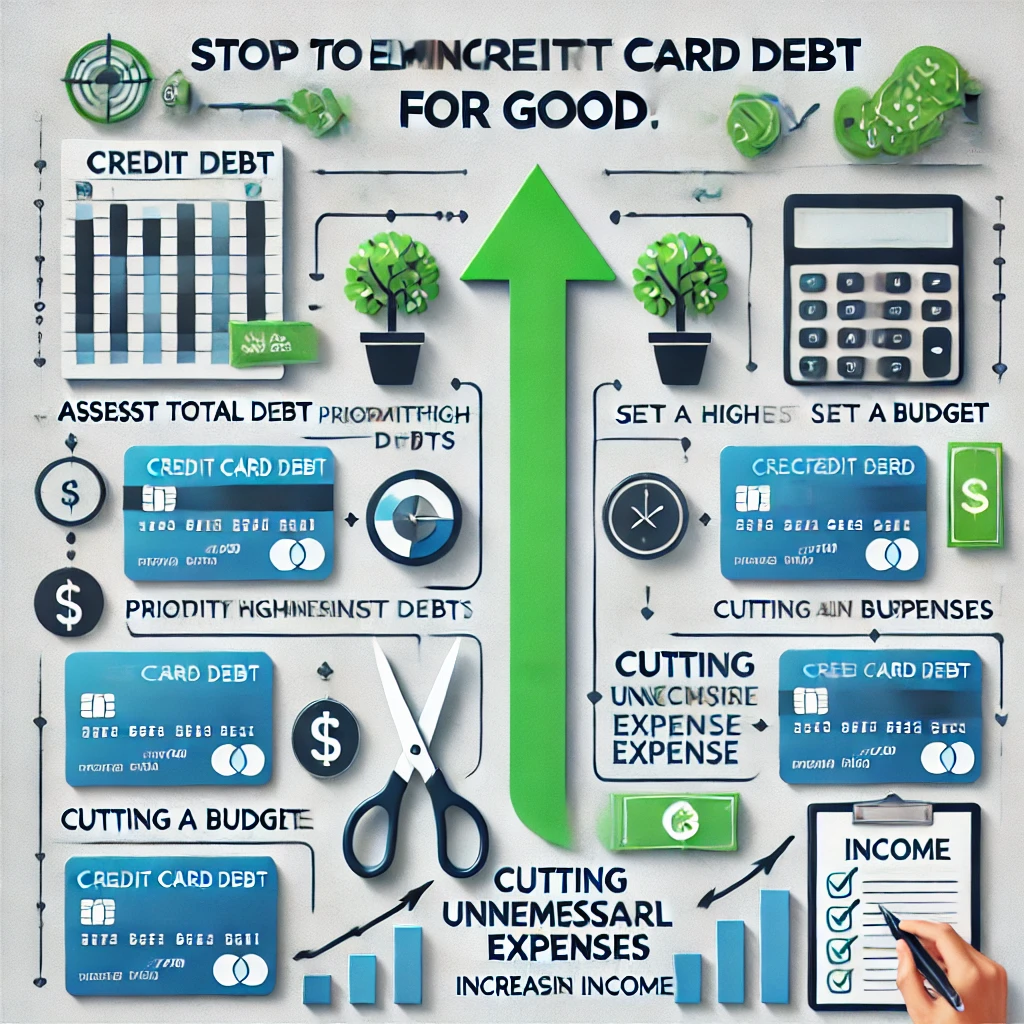
Credit card debt can feel like an overwhelming burden, with high interest rates and mounting balances making it seem impossible to escape. However, by adopting the right strategies and taking control of your finances, it is possible to get out of credit card debt for good. Whether you’re just starting your journey toward financial freedom or you’ve been struggling for years, the steps outlined below will help you break free and stay debt-free for the long term.
The Urgency of Escaping Credit Card Debt
Credit card debt is not only a financial issue—it can also become a serious threat to your overall well-being. With the average credit card interest rate hovering around 16-20%, the longer you stay in debt, the more it costs you. Over time, paying interest can consume a large chunk of your income, leaving you with less to spend on essentials and savings.
Credit card debt can spiral quickly if left unchecked, leading to increased stress, limited financial flexibility, and in some cases, even legal consequences. For those looking to build wealth or simply maintain financial stability, getting rid of credit card debt should be a top priority.
Understanding Your Debt Situation
Before you can begin your journey to eliminate credit card debt, it’s essential to fully understand your situation. Start by listing all your credit card balances, along with their interest rates and minimum payments. This allows you to see the full scope of your debt and prioritize accordingly.
Evaluate the total amount you owe, and make note of any particularly high-interest accounts. These debts are the ones that will cost you the most in the long run, so it’s crucial to focus on paying them down first.
The Psychological Impact of Debt
The stress and anxiety that come with being in debt can be just as damaging as the financial strain. Living paycheck to paycheck or constantly worrying about making minimum payments can take a toll on your mental health. It’s important to acknowledge these feelings and develop strategies to cope with the emotional side of debt.
Setting small, manageable goals, celebrating progress, and staying connected with supportive friends and family can help ease the psychological burden. Debt is a challenge, but it doesn’t have to define your life.
How to Create a Debt Repayment Plan
The most effective way to tackle credit card debt is by developing a repayment plan tailored to your financial situation. This plan should include the following steps:
- List your debts: Organize your credit card debts by balance, interest rate, and minimum payment.
- Determine your budget: Assess your income and monthly expenses to see how much you can allocate toward debt repayment.
- Choose a repayment method: Decide between the debt snowball method (paying off smaller debts first) or the debt avalanche method (focusing on higher interest debts first).
Once you’ve laid out your strategy, commit to making consistent payments and adjusting your budget to prioritize debt repayment over non-essential expenses.
Snowball vs. Avalanche Methods
Two popular approaches to debt repayment are the snowball and avalanche methods. The snowball method involves paying off the smallest debts first, allowing you to quickly gain momentum and feel accomplished. The avalanche method focuses on paying off the highest-interest debt first, saving you more money in the long run.
Each method has its benefits, and the right one for you will depend on your personal preferences. If you’re motivated by quick wins, the snowball method might be best. However, if you want to save as much money as possible, the avalanche method may be a better fit.
Prioritizing High-Interest Debt
High-interest debt should be your top priority because it costs you the most money over time. By focusing on these debts, you can reduce the amount of interest you pay and free up funds for other financial goals. Consider transferring high-interest debt to a balance transfer credit card, which offers a lower interest rate or even a 0% introductory rate for a limited time. This can help you pay off the debt faster and with less interest.
The Power of a Budget in Debt Relief
A solid budget is the cornerstone of any debt relief strategy. It allows you to see exactly where your money is going and ensures that you’re allocating enough toward debt repayment each month. A successful budget will include necessary expenses like rent and groceries, while cutting back on non-essentials such as dining out or impulse purchases.
The goal is to create enough room in your budget to make larger debt payments and accelerate your journey to being debt-free.
Cutting Down on Unnecessary Expenses
To maximize the amount of money you can put toward your credit card debt, it’s important to identify and eliminate unnecessary expenses. Start by reviewing your monthly spending and identifying areas where you can cut back. This might mean canceling subscriptions you no longer use, reducing your dining-out budget, or finding ways to save on everyday purchases like groceries.
Every dollar you save can be redirected toward your debt, helping you pay it off faster.
You can also read; How to Save Money on Everyday Expenses with Smart Habits
How to Maximize Income for Debt Repayment
While cutting expenses is one way to free up money for debt repayment, increasing your income can accelerate your progress even more. Consider taking on a side job, freelancing, or selling items you no longer need. Use any additional income to make extra payments on your credit card debt.
Another option is to negotiate a raise at your current job or look for new opportunities that offer higher pay. By combining increased income with reduced expenses, you can pay off your debt faster than you initially thought possible.